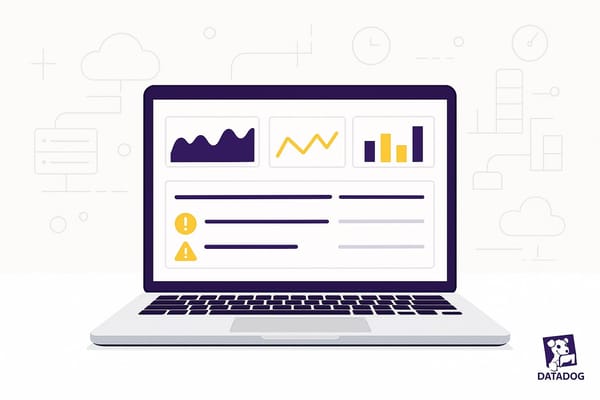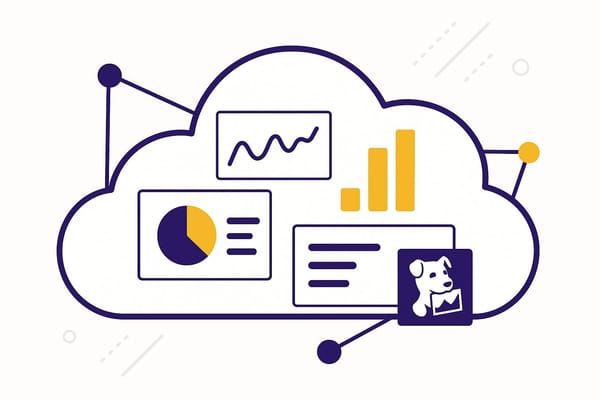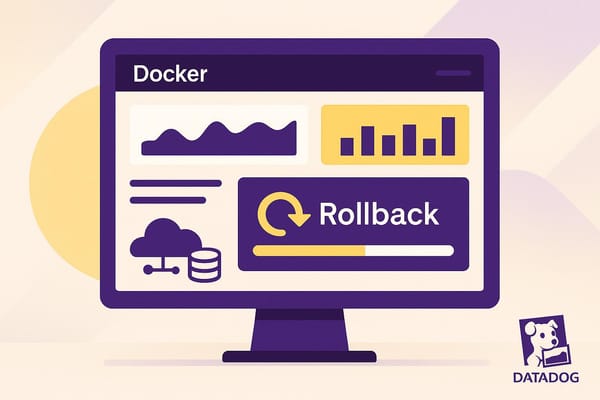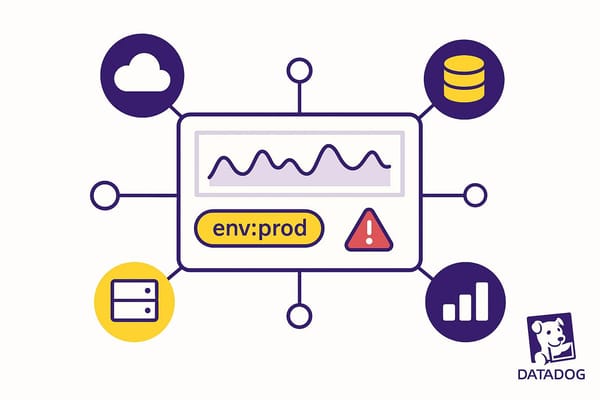Top 7 Datadog Training Resources for SMBs
Explore essential training resources for SMBs to master cloud monitoring and optimize their use of powerful analytics tools.
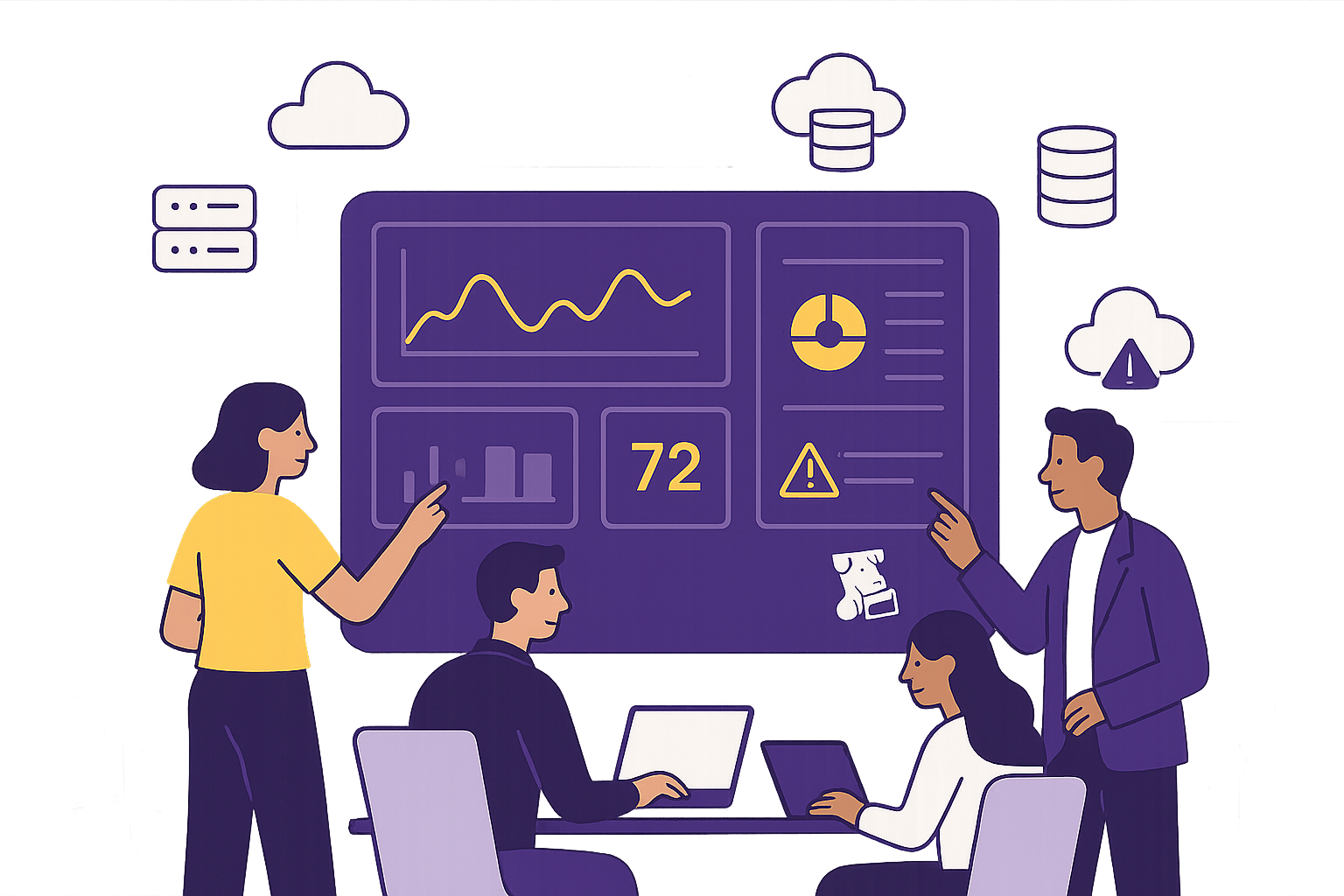
Datadog is a powerful cloud monitoring tool for SMBs, starting at $15 per host/month with a 14-day free trial. To fully leverage its features - like 850+ integrations and AI-powered analytics - proper training is essential. Here’s a quick overview of the top 7 training resources to help SMBs master Datadog:
- Datadog Learning Center: Self-paced modules with role-based learning paths and certifications for system admins, developers, and business owners.
- Certification Programs: Validate your skills with exams like Datadog Fundamentals, Log Management Fundamentals, and APM & Distributed Tracing Fundamentals.
- Udemy Courses: Affordable, in-depth video training for SMBs, covering beginner to advanced topics.
- Live Webinars: Interactive sessions with real-time Q&A for hands-on learning.
- Technical Documentation Library: Free, detailed step-by-step guides for setup, integrations, and troubleshooting.
- Interactive Sandbox Environments: Safe spaces to test features and configurations without affecting production systems.
- Scaling with Datadog for SMBs Blog: Expert tips on cost optimization, scaling, and role-based training.
Quick Tip: Start small by focusing on critical applications, then gradually expand your monitoring efforts as your team grows. Use these resources to reduce downtime, optimize costs, and make Datadog a key part of your business strategy.
Datadog 101 Course | Datadog Tutorial for Beginners | SRE | DevOps
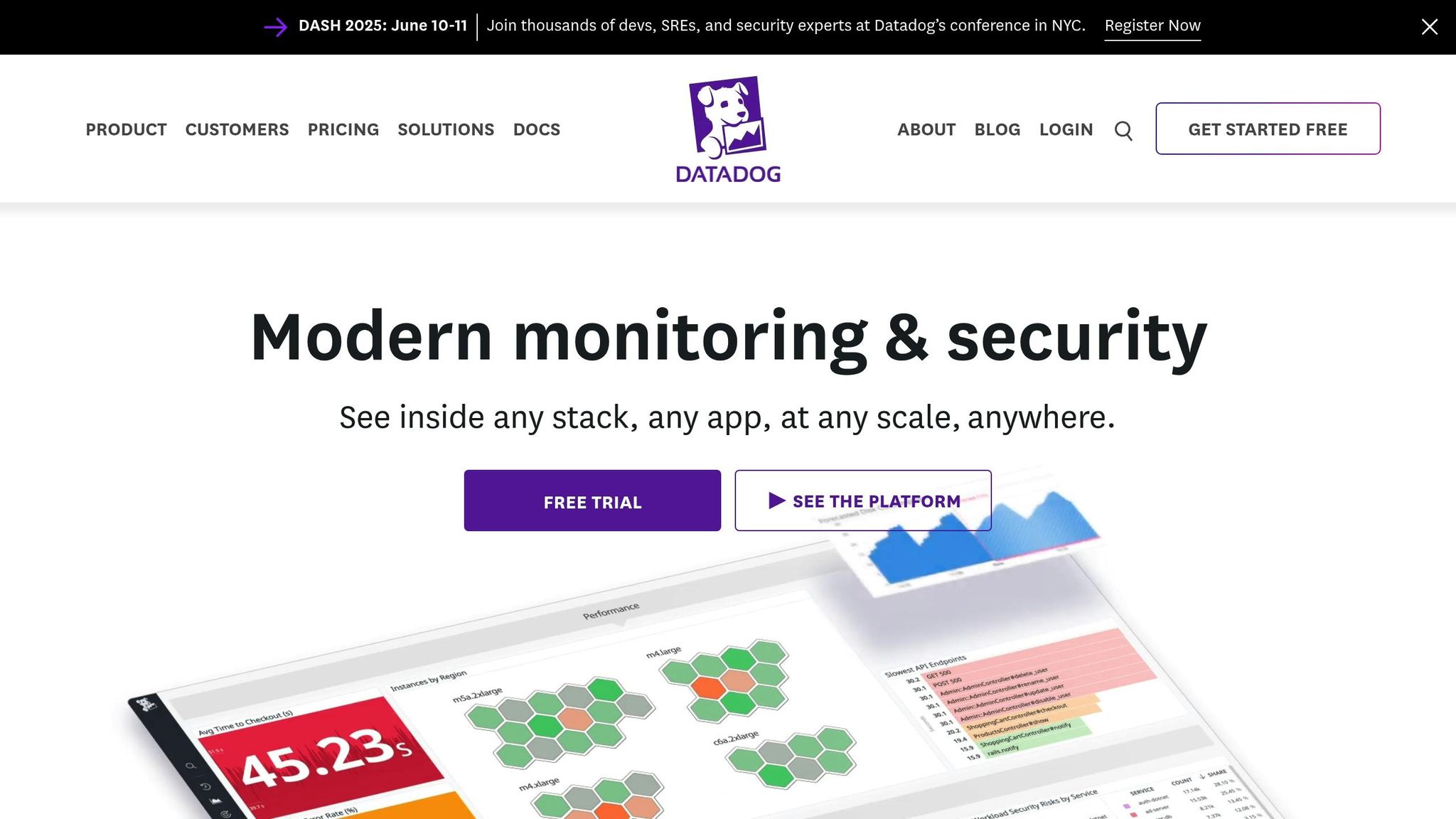
1. Datadog Learning Center Core Curriculum
The Datadog Learning Center provides a well-organized curriculum that takes users from the basics to more advanced features. It's especially helpful for small and medium-sized businesses (SMBs) that might be new to monitoring tools or have limited experience in this area.
The program uses interactive modules to reinforce key concepts, offering a hands-on learning approach. The core curriculum focuses on critical topics like setting up dashboards, configuring alerts, and utilizing over 250 integrations to connect with your existing tools. It also includes guidance on monitoring applications built with popular programming languages like Java, Ruby, PHP, Python, Go, and .NET. Additionally, it covers integration with services such as Kubernetes, Ansible, and Ubuntu, along with instructions on using API access for custom implementations.
On March 31, 2025, the Learning Center introduced persona-based learning paths and certification tracks. These additions allow you to follow a curriculum tailored to your role - whether you're a system administrator, developer, or a business owner looking to better understand your infrastructure.
The platform's self-paced format is ideal for SMBs juggling tight schedules. This curriculum lays a strong foundation for exploring more advanced Datadog training resources discussed in later sections.
2. Datadog Certification Programs
Once you’ve gotten comfortable with Datadog’s core features through the Learning Center, the next logical step is certification. Datadog’s certification programs are designed to validate the expertise of SMB teams, helping to build credibility in the DevOps space. These credentials not only enhance career opportunities but also strengthen your technical reputation.
The program includes three certification exams: Datadog Fundamentals, Log Management Fundamentals, and APM and Distributed Tracing Fundamentals. While there’s no formal prerequisite, hands-on experience with Datadog is highly recommended before attempting the exams.
| Certification Exam | Ideal Candidates | Skills Covered | Recommended Resources |
|---|---|---|---|
| Datadog Fundamentals | Beginners and entry-level users | Broad knowledge of Datadog’s platform, Linux basics, scripting, and configuring the Datadog Agent | Courses like Datadog 101 Developer + SRE, Introduction to Monitoring, and Introduction to Integrations. Also, documentation on the Datadog Agent, metrics, and monitor types |
| Log Management Fundamentals | Users with 6+ months of experience in Datadog Log Management | Log collection, parsing, searching, filtering, and analytics for troubleshooting | Courses such as Introduction to Log Management and Going Deeper with Logs: Processing. Documentation on Logs Management, Host Agent log collection, and configuration files |
| APM and Distributed Tracing Fundamentals | Users with 6+ months of experience in Datadog APM and tracing | Tracing architectures, manual instrumentation, and using Datadog APM features | Courses like Introduction to Application Performance Monitoring and Tracking Canary Deployments with Datadog. Documentation on APM, Continuous Profiler, Anomaly Monitor, and SLOs |
Each certification exam consists of 90 multiple-choice questions, has a two-hour time limit, and costs $100. You can take the exams remotely with proctoring or attend an on-site session via Webassessor. Certifications are valid for three years, and if you fail an exam three times, you’ll need to wait 180 days before trying again . The Datadog Fundamentals exam is available in English, Japanese, and Korean, while the other two exams are offered only in English . Additionally, the APM and Distributed Tracing Fundamentals exam will run as a pilot program from April 14 to June 13, 2025.
For SMBs just starting out, the Fundamentals certification is an excellent entry point. It confirms essential skills like monitoring key infrastructure and applications - critical for ensuring smooth operations. These certifications help teams maximize their use of Datadog while demonstrating their technical expertise in measurable ways.
3. Udemy's Complete Datadog Course

For small and medium-sized businesses (SMBs), Udemy's Datadog Monitoring course offers an accessible and budget-friendly way to gain in-depth knowledge. With a solid 4.5 out of 5 rating from 1,271 reviews and 9,295 learners enrolled so far, it's clear that this course has struck a chord with its audience. The program includes 11.5 hours of video content, 3 articles, and 26 downloadable resources, building on foundational concepts introduced in the Datadog Learning Center.
The course takes a hands-on approach, helping teams immediately apply what they learn to their monitoring projects. Covering everything from beginner-level basics to more advanced topics, it dives into crucial features like Log Pipeline, Trace Pipeline, and configuring the Containerized Agent. It’s tailored for monitoring, DevOps, and application development teams, with a special section dedicated to Datadog Account Management. This segment guides administrators through managing roles, permissions, API keys, and security settings.
Steven M., a participant, gave the course 5 stars, highlighting its detailed content and the instructor's expertise. However, he did mention that a few lessons could benefit from updates.
One of the most appealing aspects of Udemy's platform is its flexibility. SMB teams can learn at their own pace, making it easier to fit training into their busy schedules. For teams looking to deepen their understanding of Datadog's advanced features as their infrastructure grows, this course offers a practical and affordable solution. It also serves as a great complement to other Datadog training tools, providing self-paced instruction that adapts to the learner's needs.
4. Live Webinar Training Sessions
Datadog's Foundation Enablement Sessions offer live, hands-on training tailored for SMBs. These webinars are available worldwide, with automatic local time adjustments to make scheduling simple and convenient. They’re designed to provide practical, in-depth learning experiences.
The sessions are interactive, with experts sharing actionable tips and insights on everything from setting up Datadog to mastering advanced monitoring techniques. Whether you're just getting started or already familiar with the platform, there's something here for everyone.
A standout feature is the real-time Q&A, where participants can ask specific questions and get immediate answers from experts. This not only speeds up problem-solving but also helps teams avoid common mistakes.
To join an upcoming session, head to the "Events & Webinars" section on the Datadog website. Simply choose a session that fits your schedule, complete the registration form, and you'll receive all the details you need to connect.
If your team can’t make it to a live session, don’t worry - Datadog's Technical Enablement Services provide recordings and key documentation. This way, you can still access all the valuable content at your convenience.
These webinars are a great way to get real-time feedback, tackle specific challenges, and stay informed about the latest Datadog features. They combine expert guidance with the personal touch of live interaction.
5. Datadog Technical Documentation Library
The Datadog Technical Documentation Library is a go-to resource for everything from basic setup to advanced troubleshooting. It's particularly handy for SMBs looking for reliable, no-cost guidance to master the platform.
What sets this library apart is its comprehensive coverage. You'll find detailed step-by-step guides for agent installation across multiple operating systems, including Windows, Ubuntu, CentOS, and Mac OS X. It also dives into integrations with major cloud platforms like AWS, Azure, and Google Cloud, as well as infrastructure tools like Terraform and Ansible.
The content is thoughtfully organized into sections that mirror how SMBs typically use Datadog. The Getting Started section helps users with the initial setup, while other areas focus on key features like APM tracing, container monitoring, dashboard creation, and log management. There's also a wealth of information on database monitoring, security tools, and workflow automation - features that growing businesses often rely on.
For development teams, the library includes guides on custom checks, DogStatsD, and IDE plugins. Whether your team is creating custom monitoring scripts or embedding Datadog into their development processes, the documentation ensures they have the answers they need.
The troubleshooting section is another highlight, offering clear, step-by-step solutions to common problems like agent errors, Kubernetes issues, and serverless function challenges. Each guide includes detailed instructions and examples of common error scenarios to help you resolve issues effectively.
One particularly useful feature is the library's search functionality. If you're dealing with a specific error message or need help with a certain feature, you can quickly locate the relevant guide without wading through unrelated content.
The documentation also includes practical, ready-to-use examples. For instance, it provides grok parser helper rules for log parsing, complete with examples like Apache access log patterns. These examples show you how to extract valuable data, such as client IP addresses, timestamps, and status codes, right out of your logs.
With Datadog supporting over 600 integrations, the library ensures there's guidance for nearly every tool in your tech stack. This breadth of coverage means you’ll rarely hit a roadblock when setting up monitoring for your unique environment. And if you're looking for hands-on experience, check out the interactive sandbox environments for practical Datadog training.
6. Interactive Sandbox Environments
Interactive sandbox environments offer SMBs a safe space to explore Datadog's features without risking production stability. Think of it as a testing ground where you can experiment with configurations, try out new monitoring setups, and get comfortable with how different features operate - all before applying them in a live environment.
Datadog engineers rely on sandbox environments to replicate production setups, using tools like Vagrant and Terraform. These tools help recreate unique customer conditions and tackle scalability challenges, allowing teams to collaboratively build, manage, and share test setups.
In this controlled space, you can intentionally introduce misconfigurations, simulate extreme scenarios, or test failure conditions without impacting your actual systems. This approach encourages experimentation and learning while ensuring your production environment remains unaffected.
Creating a sandbox involves setting up a working directory, configuration file, virtual environment, and a setup script to mimic production conditions. While setting this up might require some technical effort, the reward is a risk-free environment that mirrors your live systems.
The hands-on experience is invaluable. You can build dashboards, test various scenarios, and see immediate results. By simulating normal usage, edge cases, error handling, and even high-load conditions, you gain a deeper understanding of how Datadog performs in different situations. This practical application reinforces any theoretical knowledge gained from earlier training.
For SMBs, sandbox environments are especially useful for training team members. They provide a space to practice setting up integrations, creating custom metrics, and troubleshooting - all while keeping your production systems untouched.
To get the most out of a sandbox, start small. Focus on your most critical applications and infrastructure first, then gradually expand to other areas. This step-by-step approach helps build confidence and ensures you prioritize what’s most important for your business operations.
Documentation is key to making the most of your sandbox environment. Keep detailed records of your system setups, data flows, integration processes, and any troubleshooting steps you uncover. As Kristen Womack of Night Sky Web Co. puts it:
"Documentation outlines how to access and use your API."
Finally, sandbox environments are perfect for exploring Datadog's wide range of integrations. You can experiment with different options to see which align best with your business needs before rolling them out in production. By combining hands-on practice with other training resources, sandbox environments provide a well-rounded learning experience.
7. Scaling with Datadog for SMBs Blog
The Scaling with Datadog for SMBs blog (https://datadog.criticalcloud.ai) is a go-to resource for small and medium-sized businesses (SMBs) looking to make the most of Datadog's monitoring platform. It’s packed with expert advice and actionable tips tailored to the unique challenges SMBs face, such as limited budgets, smaller teams, and fewer resources. This blog works hand-in-hand with the training tools mentioned earlier, turning technical know-how into practical strategies that deliver real business value.
Key topics include cost optimization, helping SMBs identify unused resources, cut down on cloud expenses, and use machine learning forecasts to plan for future capacity. These insights are especially helpful for businesses that are growing and need to manage their scaling efforts wisely.
The blog suggests starting small - focus on monitoring your most critical applications and infrastructure first. As your system grows, you can gradually expand your monitoring efforts. This approach not only prevents alert fatigue but also ensures your team gets targeted, automated notifications that highlight actual issues, cutting through the noise of unnecessary alerts.
Additionally, the blog provides role-based training paths to boost your team’s skills and align monitoring efforts with clear, actionable KPIs. This ensures that the time and money spent on monitoring directly contribute to measurable business outcomes. Whether you’re training a single DevOps engineer or rolling out monitoring practices across your organization, the insights scale to fit your needs. By following these strategies, SMB teams can fully leverage Datadog’s features while driving meaningful growth for their business.
Conclusion
Datadog training can transform how SMBs manage their systems, helping to improve monitoring, speed up incident response, and fine-tune cloud infrastructure. The seven resources mentioned earlier offer a solid foundation for teams to build their skills and gain confidence in using Datadog effectively. These benefits aren’t just theoretical - they’re backed by real-world results.
Take Peloton, for instance. They managed to cut response times by up to 90% in just 30–45 days. Similarly, the Asian Development Bank pinpointed critical issues within two weeks, while Neto ensured uninterrupted monitoring throughout an 18-month AWS migration. These examples show how mastering Datadog can turn monitoring into a proactive tool for business success.
To get the most out of Datadog, start small - focus on critical applications first. As your skills grow, expand your monitoring efforts. Set clear KPIs and automate alerts to concentrate on what really matters, instead of getting bogged down by noise.
Whether you're a solo DevOps engineer or part of an expanding team, resources like official documentation, certifications, sandbox environments, and SMB-specific guidance can help you turn technical expertise into real business impact. Dive into these tools today to reduce downtime, improve performance, and make Datadog a key part of your growth strategy.
FAQs
What benefits does Datadog's Learning Center offer SMBs new to monitoring tools?
Datadog's Learning Center is packed with training resources aimed at helping small and medium-sized businesses (SMBs) get the most out of its monitoring platform. With a combination of on-demand and live sessions, users can choose a learning pace that works for them while picking up practical skills in observability and best practices.
The courses are thoughtfully structured with SMBs in mind, simplifying the process of onboarding and managing cloud infrastructure. By diving into Datadog's features, businesses can boost system performance, trim operational costs, and confidently scale their operations.
How can small businesses safely practice using Datadog without affecting their live systems?
Small businesses can take advantage of sandbox environments to practice and refine their Datadog skills without jeopardizing their production systems. A sandbox is essentially a safe, isolated testing space that simulates real-world conditions. This setup lets users experiment with Datadog features - like dashboards, alerts, and integrations - without any risk to live operations.
Datadog provides sandbox accounts where users can send test data, fine-tune configurations, and explore the platform's features in a hands-on way. On top of that, Datadog's Learning Center includes sandbox environments for practical exercises, making it easier to build confidence and expertise. These tools allow small businesses to fully understand Datadog's capabilities while ensuring their live systems remain protected.
How can SMBs prepare for Datadog certification exams, and why are these certifications valuable for their business?
How to Prepare for Datadog Certification Exams
For small and medium-sized businesses (SMBs) looking to prepare for Datadog certification exams, there are a few steps that can make the process smoother. Start by diving into Datadog’s core features and tools using resources like online courses, tutorials, and official documentation. These materials offer a solid foundation. Next, hands-on practice is a must - spend time exploring Datadog’s monitoring and analytics capabilities to build confidence and familiarity. Another great tip? Join community forums or study groups. Connecting with others who are also preparing can provide helpful insights and support.
Why Datadog Certification Matters for SMBs
Earning a Datadog certification isn’t just a personal accomplishment - it can bring real benefits to your business. Certified employees are better equipped to use Datadog effectively, leading to improved system monitoring, less downtime, and smoother operations overall. Plus, certifications boost your company’s credibility. They highlight your team’s expertise in managing cloud infrastructure, which can set you apart from competitors and strengthen your position in the market.

